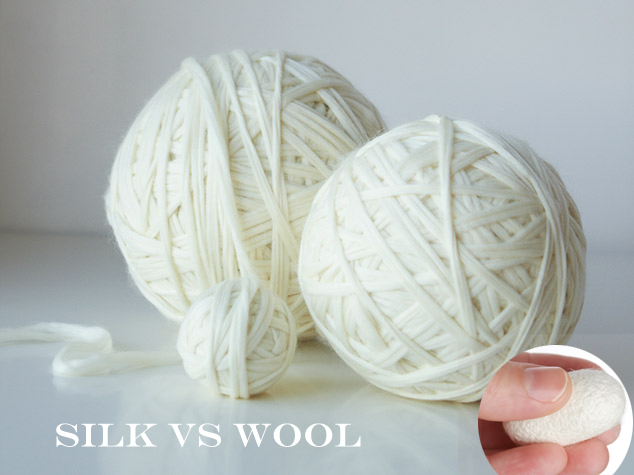In the last few weeks, I have written several articles on the comparison between silk and various commonly seen textiles. This is going to be the last article in the series, and in this article I’m going to take a look at the various differences between silk and wool, and how these differences affect your purchase decisions.
One distinct difference between wool and other fibers I have mentioned before is that wool, like silk, is a completely natural animal fiber. As such, it shares a lot of similarities with silk in terms of chemical composition and fiber structures. Both wool and silk have high affinity with human skin and are suitable for most people.
So what are the differences between silk and wool?
– Warmth Keeping:
If you look at why wool and silk was there in the first place, you should have an idea of the basic difference between them: warmth keeping. Sheeps grow wool to keep themselves warm first and foremost, while silkworms make cocoons to shield themselves from harm during metamorphosis. These functions persist when wool and silk are cultivated and made into blankets and comforters.
Wool:
Wool is a great insulator of heat. The natural air pockets in wool help to efficiently keep the heat emanated by the human body inside and help people stay warm during cold weather. This is why sweaters are made of wool.
Silk:
Silk is also great in terms of insulation. However, most silk comforters and blankets don’t have the same density as their wool counterparts, meaning that they are not as good in terms of keeping warmth. However, due to the structure of silk fibers and most silk products being thinner, silk is better at facilitating air exchanges between the 2 sides of the comforter (more commonly known as breathing), which helps with venting excessive heat if required and keeping the temperature around the human body at a comfortable level.
– Comfort:
Weight:
Wool is quite light, but silk is still significantly lighter. Lighter comforter eases the difficulty of turning during sleep and promotes better blood flow throughout the night.
Touch:
Both wool and silk are soft to the touch. Silk, being thinner, feels more flowy while wool is more solid. It comes down to preference in this category.
Feel:
The word “silky smooth” perfectly describes how silk feels on the skin. Wool cloth feels a bit rougher due to the surface of wool fibers being scaly instead of smooth like silk fibers. Also, due to the structure of the wool fibers, it is easy for wool to fray on the surface, creating broken strands of wool fiber which may cause skin to itch.
– Hygiene:
Wool is not particularly resistant to any type of bacteria, mold or bugs because sheeps have skin for those. Silk, on the other hand, is naturally resistant to bacteria and mold, and repels most types household bugs because silkworms rely on these abilities to protect themselves. This not only means that silk tends to stay cleaner, but also that it keeps away some of the most common household allergens away from your bedroom.
– Maintenance:
Due to the factors listed in the Hygiene section, wool generally requires more care and maintenance in terms of cleaning, while silk is easier to clean. Both wool and silk require dry cleaning if you wish to clean them thoroughly. Lower momme weight silk tends to be more fragile than wool and doesn’t resist wear and tear as well, which is why we recommend silk equal to or above 19 momme.
Overall, both silk and wool are great textiles and worth getting. If you are more concerned about staying warm and overheating doesn’t bother you, wool is the more reasonable choice. If you wish to buy something that can be used throughout the year, that is lighter and more hygenic, then silk would be the better choice.

